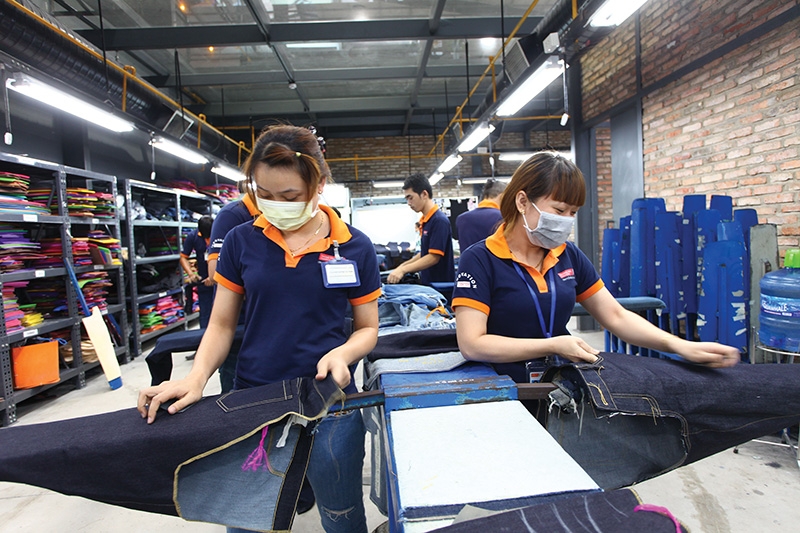Textilers adhering to strict measures
 |
| Textile groups are looking for a clearer path towards financial stability into next year, Photo Le Toan |
Century Synthetic Fibre Corporation (CSF), which engages in the manufacture and sale of draw-textured yarn products, is still in operation under the “three on the spot” model. Under the model, enterprises can remain open if they can offer meals and a space to rest and sleep for employees, as requested by Ho Chi Minh City authorities.
In the first half of 2021, CSF recorded positive results with net revenues of more than $43.39 million and after-tax profit of $6.11 million, an increase of 24 and 157 per cent, respectively, from the same period last year. The growth is attributable to the recovery of key export markets such as the United States and the European Union in the second quarter, as well as the increase in the orders for recycled goods.
Nguyen Phuong Chi, strategic director of CSF, told VIR that the company had already arranged for workers to stay within the factories’ premises. Despite the increase in operating costs, this measure will ensure the company’s seamless operation. “A few of our customers who cannot immediately meet the requirements are temporarily delaying shipment,” she said.
Meanwhile, Thanh Cong Textile Garment Investment Trading JSC generated $81.1 million in revenues and $5 million in after-tax profits in the first half, up 11 and 4.3 per cent, respectively, over the same period last year.
However, the company is struggling with the outbreak in Ho Chi Minh City. Tran Nhu Tung, chairman of Thanh Cong Textile Garment Investment Trading JSC, said that textile factories often employ a large number of workers so it is quite difficult to arrange on-site accommodation for all. Thus, the company has to let only 50 per cent of its 5,000 workers stay at the factory. “Although we have numerous orders on the back of the rebounding demand in key export markets, the reduced capacity will affect our manufacturing activities,” he added.
Meanwhile, Vietnam National Textile and Garment Group (Vinatex) also gained revenues of VND7.25 trillion ($314.57 million) in the first half, equal to the results of the same period of 2020.
According to Vu Duc Giang, chairman of the Vietnam Textile and Apparel Association (Vitas), this is partly due to increasing orders which were up by 25-30 per cent from last year. “The amount of orders is abundant as consumption in major countries has grown strongly,” he stated.
The outlook for the textile and garment industry in the second half of this year has been dampened somewhat.
“Along with the prime minister’s Directive No.16/CT-TTg issued in March 2020 on social distancing measures imposed in Ho Chi Minh City, and 19 cities and provinces, the southern authorities are striving to tighten prevention measures, which a vast majority of factories cannot meet,” Giang said.
He claimed that it is hard to anticipate the export picture of the sector for the rest of the year. “We don’t know how long social distancing will last. Vitas is monitoring the implementation of Directive 16. We will propose the government remove the bottlenecks of ‘three on the spot’ for businesses to soon return to production, as well as consider policies to support employees to return to work,” he said.
Only then, Giang explained, can the country expect growth in the latter months of 2021 reaching the export target set by the whole industry of $39 billion in 2021.
From the perspective of a yarn business, Chi from CSF noted that given the reopening in the EU and US markets, the demand for yarn has recovered. “In addition, as the demand for environmentally-friendly products is rising, the sales of recycled polyester, which is one of the company’s flagship products, has been increasing. Therefore, we expect that if Vietnam can successfully contain the current outbreak, the business prospects in the second half will be the same or even better than the first half,” Chi added.
Textiles and garments, one of the key export industries of Vietnam, have achieved positive results in the first half of the year with $18.46 trillion of the export turnover, an increase of over 20 per cent over the same period in 2020.
What the stars mean:
★ Poor ★ ★ Promising ★★★ Good ★★★★ Very good ★★★★★ Exceptional
 Tag:
Tag:
Themes: COVID-19
- 67 million children missed out on vaccines because of Covid: UNICEF
- Vietnam records 305 COVID-19 cases on October 30
- 671 new COVID-19 cases recorded on October 1
- Vietnam logs additional 2,287 COVID-19 cases on Sept. 21
- People’s support decisive to vaccination coverage expansion: official
Related Contents
Latest News
More News
- Vietnam eases policy approval requirements, simplifies foreign and outbound investments (December 11, 2025 | 17:53)
- Unpacking new momentum in Vietnam’s M&A market (December 10, 2025 | 09:59)
- Forum honours outstanding M&A deals, strategies, and advisory firms (December 09, 2025 | 18:22)
- Vietnam enters defining phase of M&A growth (December 09, 2025 | 17:00)
- Vietnam’s M&A market opens new opportunities amid strong economic momentum (December 09, 2025 | 15:00)
- Vietnam M&A Forum 2025: new position, new momentum (December 09, 2025 | 14:30)
- FDI in Vietnam jumps on additional capital and share purchases (December 09, 2025 | 13:56)
- VIR gathers dealmakers for M&A forum (December 08, 2025 | 17:17)
- Vietnam steps up green transformation with strong policies and rising investment demand (December 06, 2025 | 12:07)
- Listed companies honoured for information transparency (December 06, 2025 | 11:59)
























 Mobile Version
Mobile Version